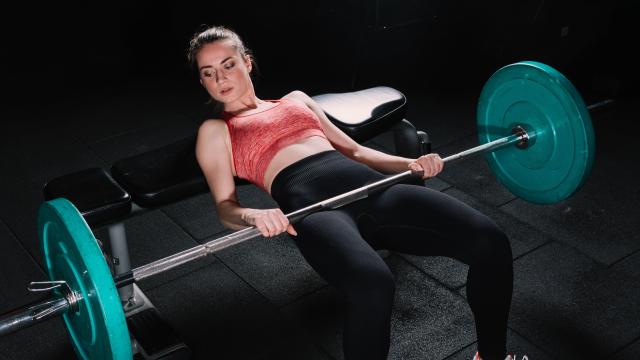We lift to grow and strengthen our muscles, so it’s natural that a lot of us find bodybuilders’ piece-by-piece mindset appealing: You focus on the specific muscle that you want to work, and make sure that you feel it working.
But what happens if you do a glute exercise but you don’t feel it in your butt? Or you do a lat pulldown but you only feel it in your biceps? Here’s a guide.
You may not always feel a muscle, even if it’s working
Here’s the most important thing to know: you don’t have to feel a muscle for it to be working. Say you’re doing a pullup: Your lats are working whether you feel them or not. The lats are the upper back muscles that bring your arms closer to your torso, so a pullup simply cannot happen unless your lats are getting engaged.
Or take squats. A barbell squat works your quads, your glutes, and a lot of other muscles besides. But when you’re doing a heavy squat, your brain is processing a lot of information. It’s feeling the weight of the bar on your back. It’s remembering the technique cues that you’re trying to focus on. It’s paying attention to your balance as you descend to make sure you don’t tip over one way or another. It’s counting the number of the rep in your head. Maybe sometimes a muscle manages to pipe up with “hey, I’m your quads and I’m kind of hurting right now.” But your brain does not have time to listen to every muscle’s nonsense, any more than a mum making dinner has time to listen to her toddler’s every whine. It is busy making sure you complete the rep.
I like to think of some muscles as being “louder” than others. If I’m doing kettlebell swings, I might be more focused on the fact that my forearms are burning (from holding onto the kettlebell) and not feel my glutes working at all. But after 100 swings, hoo boy, you can bet my butt will be feeling like jelly afterward. It just didn’t give me that burning sensation in the moment.
When it matters whether you feel the burn, and when it doesn’t
So what should you do if you don’t feel the muscle working? You look for another way to be sure the muscle is working. In the case of the compound exercises mentioned above, the fact that you completed the exercise is all the information you need. Your pullups used your lats. Your kettlebell swings and your squats used your glutes. There’s simply no way around that.
Does it ever matter whether you’re feeling the muscle? Yes, it can help if you’re doing isolation exercises. In these exercises, like a bicep curl or a leg extension, you’re trying to focus a movement on one muscle or a small muscle group.
For example, let’s say you’re doing side-lying leg raises to work your hip adductors, and especially your glutes. If you have your legs angled slightly forward, you may feel the muscles toward the front of your hips working. But if you do the same exercise with your back to a wall, sliding your heel along the wall as your lift your leg, you’ll feel it a lot more in that glute you’re trying to isolate.
As a general rule, for compound exercises (where many muscles are working at once), it doesn’t matter whether you feel the muscle. But if you are doing an isolation exercise, feeling the muscle is helpful feedback to make sure that you are isolating the right muscle.
What not to do
There’s a lot of bad advice out there, and I’d like to call out one thing specifically: the advice to reduce the amount of weight you’re lifting so that you can feel the muscles better. Sometimes people will say it’s important to build a “mind-muscle connection.”
But you don’t have to forgo weight the bar to build that connection. If you’d like to spend more time feeling the muscle, do some isolation work in your warmups. (These are sometimes called “activation” exercises.) You can also do extra isolation work at the end of your workout just to give those specific muscles a little more volume.
It’s important to remember that different parts of your workout have different purposes. If you’re squatting heavy, you need to put some fucking weight on the bar to keep building your strength and your skill at squatting. Often the lifts that make it hardest to feel a muscle are the lifts where that muscle is working the most! So don’t give up on heavy, effective lifts just because you don’t “feel” them as well as isolations or warmups.

Leave a Reply
You must be logged in to post a comment.